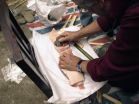(Press-News.org) The hand moves the computer mouse, but the cursor doesn't comply. The cursor doesn't go where told.
The hand tries again. The cursor shoots past the intended target.
The hand tries a third time – and the cursor loops farther from the target than where it started. And the user is frustrated.
So it often goes for computer users whose motor disabilities prevent them from easily using a mouse.
As the population ages, more people are having trouble with motor control, but a University of Washington team has invented two mouse cursors that make clicking targets a whole lot easier. And neither requires additional computer hardware – just some free, downloadable software. The researchers hope that in exchange for the software, users offer feedback.
The Pointing Magnifier combines an area cursor with visual and motor magnification, reducing need for fine, precise pointing. The UW's AIM Research Group, which invented the Pointing Magnifier, learned that users can much more easily acquire targets, even small ones, 23 percent faster with the Pointing Magnifier.
The magnifier runs on Windows-based computer systems. It replaces the conventional cursor with a larger, circular cursor that can be made even larger for users who have less motor control. To acquire a target, the user places the large cursor somewhere over the target, and clicks. The Pointing Magnifier then magnifies everything under that circular area until it fills the screen, making even tiny targets large. The user then clicks with a point cursor inside that magnified area, acquiring the target. Although the Pointing Magnifier requires two clicks, it's much easier to use than a conventional mouse, which can require many clicks to connect with a target.
Screen magnifiers for people with visual impairments have been around a long time, but such magnifiers affect only the size of screen pixels, not the motor space in which users act, thus offering no benefit to users with motor impairments. The Pointing Magnifier enlarges both visual and motor space.
Software for the Pointing Magnifier includes a control panel that allows the user to adjust color, transparency level, magnification factor, and area cursor size. User preferences are saved when the application is closed. Keyboard shortcuts quickly enable or disable the Pointing Magnifier. The UW team is also making shortcuts customizable.
"It's less expensive to create computer solutions for people who have disabilities if you focus on software rather than specialized hardware, and software is usually easier to procure than hardware," said Jacob O. Wobbrock, an assistant professor in the Information School who leads the AIM Group.
His group's paper on enhanced area cursors, including the Pointing Magnifier, was presented at the 2010 User Interface Software and Technology symposium in New York. A follow-on paper will be presented at a similar conference in May.
Another AIM technology, the Angle Mouse, similarly helps people with disabilities. Like the Pointing Magnifier, it may be downloaded, and two videos, one for general audiences and another for academic ones, are available as well.
When the Angle Mouse cursor initially blasts towards a target, the spread of movement angles, even for people with motor impairments, tends to be narrow, so the Angle Mouse keeps the cursor moving fast. However, when the cursor nears its target and the user tries to land, the angles formed by movements diverge sharply, so the Angle Mouse slows the cursor, enlarges motor space and makes the target easier to get into. The more trouble a user has, the larger the target will be made in motor space. (The target's visual appearance will not change.)
Wobbrock compares the Angle Mouse to a race car. "On a straightaway, when the path is open, the car whips along, but in a tight corner, the car slows and makes a series of precise corrections, ensuring its accuracy."
A study of the Angle Mouse included 16 people, half of whom had motor impairments. The Angle Mouse improved motor-impaired pointing performance by 10 percent over the regular Windows™ default mouse and 11 percent over sticky icons – an earlier innovation in which targets slow the cursor when it is inside them.
"Pointing is an essential part of using a computer, but it can be quite difficult and time consuming if dexterity is a problem," Wobbrock said. "Even shaving one second off each time a person points may save hours over the course of a year."
Wobbrock suggests that users try both the Pointing Magnifier and the Angle Mouse before deciding which they prefer.
"Our cursors make ubiquitous mice, touchpads, and trackballs more effective for people with motor impairments without requiring new, custom hardware," Wobbrock said. "We're achieving accessibility by improving devices that computer users already have. Making computers friendlier for everyone is the whole point of our work."
INFORMATION:
The Pointing Magnifier work was funded by the National Science Foundation and the Natural Sciences and Engineering Research Council of Canada.
Co-authors of the research paper that included the Pointing Magnifier are Leah Findlater, Alex Jansen, Kristen Shinohara, Morgan Dixon, Peter Kamb, Joshua Rakita and Wobbrock.
The Angle Mouse work was supported by Microsoft Research, Intel Research and the National Science Foundation.
Co-authors of the Angle Mouse paper are Wobbrock, James Fogarty, Shih-Yen (Sean) Liu, Shunichi Kimuro, and Susumi Harada.
For more information or to provide feedback on the cursors, contact Wobbrock at 206-616-2541 or wobbrock@uw.edu.
Free software makes computer mouse easier for people with disabilities
2011-04-09
ELSE PRESS RELEASES FROM THIS DATE:
US House budget plans would jeopardize scientific research facilities
2011-04-09
WASHINGTON, D.C. – It is important that the United States begin to live within its means and address the federal deficit. But APS believes that as a nation we need to be smart about how we do it. Cutting spending across the board without a clear understanding of what it means for America's future jeopardizes the very future we want to secure for our children.
For more than half a century, science and technology have been the primary drivers of job creation and economic growth. Slashing spending on science, as the budget plans of the House of Representatives call for, ...
Are invasive plants a threat to native biodiversity? It depends on the spatial scale
2011-04-09
The phrase "invasive plant species" typically evokes negative images such as broad swaths of kudzu smothered trees along the highway or purple loosestrife taking over wetlands and clogging waterways—and as such, invasive plants are largely viewed as major threats to native biodiversity. However, research has shown both that invasive species may be one of the most important threats to biodiversity and that plant invasions are rarely the cause for native species extinctions. How can these conflicting pieces of evidence be reconciled?
Kristin Powell, from Washington University, ...
Reformed Medicaid program must put coordinated care at forefront of efforts
2011-04-09
SAN DIEGO, April 8, 2011 -- A reformed Medicaid program must put coordinated primary care at the forefront of its efforts, the American College of Physicians (ACP) said in a new position paper released today at Internal Medicine 2011, ACP's annual scientific meeting. Medicaid and Health Care Reform highlights how primary care physicians will assume a major role in providing care to Medicaid beneficiaries.
"The Medicaid program faces significant changes in the next few years as millions of current and newly eligible people will receive Medicaid coverage," said J. Fred ...
Americans' views of college access varied, often inflated
2011-04-09
A study by Indiana University sociologists found that many Americans had inflated views of minority students' opportunities to attend college, yet a large contingent - around 43 percent of people surveyed - believed that low income students had fewer opportunities for college access.
The study, which will be discussed on Monday at the American Educational Research Association's meeting in New Orleans, found that Americans have varying beliefs when it comes to college access. A quarter of the people interviewed thought minority and low-income students held a better position ...
NIH researchers identify cause and new treatment for common recurrent fever in children
2011-04-09
A preliminary study conducted by a team at the National Institutes of Health has identified a promising new treatment in children for the most common form of a rare disorder. The syndrome is called periodic fever associated with aphthous stomatitis, pharyngitis and cervical adenitis — or PFAPA — and is characterized by monthly flare-ups of fever, accompanied by sore throat, swollen glands and mouth lesions.
The proposed treatment, which will be validated in a larger study before it is recommended in treating PFAPA syndrome, wards off an inappropriate immune system attack ...
Prompt Proofing Blog Post: How to Improve Your Writing - Part 1
2011-04-09
VANCOUVER, BC, April 09, 2011 /24-7PressRelease/ -- This is the first of a six-part series on improving your writing style. Whether you write for business or academic purposes, there are a few golden rules that will help you sharpen up your prose.
Part 1: Avoid wordiness and repetition
Many of us fall into this trap, for various reasons. Possibly this is just a bad habit we have got into or perhaps we feel that we need to have extra words, either to reinforce our point, or (Heaven forbid) to 'pad out' our academic writing to make up a stipulated word count. If you ...
Scientists make bamboo tools to test theory explaining East Asia's Stone Age tool scarcity
2011-04-08
The long-held theory that early human ancestors in East Asia crafted their tools from bamboo and wood is much more complicated than originally conceived, according to a new study.
Research until now has failed to address a fundamental question: Is it even possible to make complex bamboo tools with simple stone tools?
Now an experimental archaeological study — in which a modern-day flint knapper replicated the crafting of bamboo knives — confirms that it is indeed possible to make a variety of bamboo tools with the simplest stone tools.
However, rather than confirming ...
Ancient fossils hold clues for predicting future climate change, scientists report
2011-04-08
By studying fossilized mollusks from some 3.5 million years ago, UCLA geoscientists and colleagues have been able to construct an ancient climate record that holds clues about the long-term effects of Earth's current levels of atmospheric carbon dioxide, a key contributor to global climate change.
Two novel geochemical techniques used to determine the temperature at which the mollusk shells were formed suggest that summertime Arctic temperatures during the early Pliocene epoch (3.5 million to 4 million years ago) may have been a staggering 18 to 28 degrees Fahrenheit ...
Bioengineering with vetiver grass on Guam
2011-04-08
Mohammad Golabi, a soil science professor at the University of Guam, has put his years of research on vetiver grass to practical use in shielding the reefs in Pago Bay from the harmful effects of construction-induced run-off.
One of the major health hazards facing Guam's reefs is soil erosion resulting in sedimentation and suffocation of the complex organisms that make up a reef system. "Vetiver's ability to tolerate high stress situations, adapt to a variety of conditions, develop a dense vertical root system, and powerful soil binding characteristics make it an ideal ...
UMD Solar Decathlon team unveils 'WaterShed'
2011-04-08
COLLEGE PARK, Md. - The University of Maryland Solar Decathlon Team has unveiled its entry in the U.S. Department of Energy competition - a high-tech structure they call WaterShed, because it integrates a unique array of sustainable features designed to protect and make the most of the Chesapeake Bay.
The unveiling ceremony brought together officials and the dozens of students, faculty and mentors that make up the Maryland team, one of only 20 finalists in the international competition. Each team designs and builds a house that runs on solar power. The final Solar Decathlon ...




